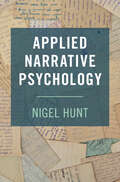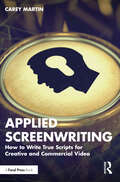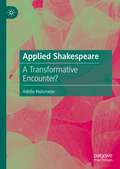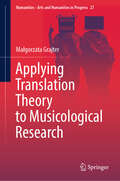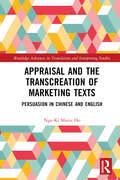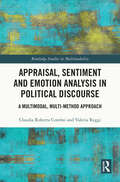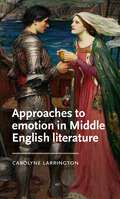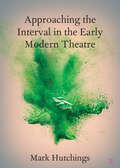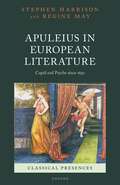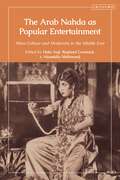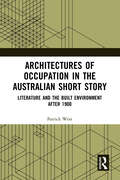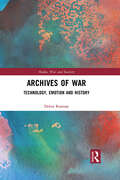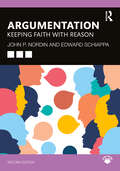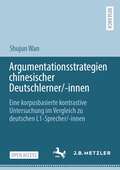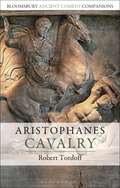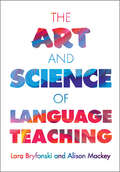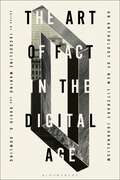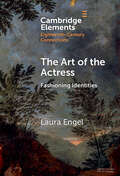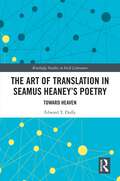- Table View
- List View
Applied Screenwriting: How to Write True Scripts for Creative and Commercial Video
by Carey MartinPutting a vision on the page for creative and commercial video is harder than it seems, but author Carey Martin explains how to bring these tools to bear in the “work for hire” environment. Whilst other texts focus on writing the next award winner, this can be out of reach both logistically and financially for many. Instead, readers will learn how to write what they want the eyes of the audience to see and the ears of the audience to hear, in such a way that the Producer and Director can read the creative blueprint and bring that vision to life. The text will walk readers through a focused and practical consideration of the camera, the edit, and the sound design, in addition to a straightforward application of basic story principles. By understanding writing for video as more than creating a recorded play, readers will become more effective screenwriters and, should they wish, Producers and Directors as well. This book is ideal for students of screenwriting and those writing scripts for message-driven video for corporate, nonprofit, and commercial production.
Applied Screenwriting: How to Write True Scripts for Creative and Commercial Video
by Carey MartinPutting a vision on the page for creative and commercial video is harder than it seems, but author Carey Martin explains how to bring these tools to bear in the “work for hire” environment. Whilst other texts focus on writing the next award winner, this can be out of reach both logistically and financially for many. Instead, readers will learn how to write what they want the eyes of the audience to see and the ears of the audience to hear, in such a way that the Producer and Director can read the creative blueprint and bring that vision to life. The text will walk readers through a focused and practical consideration of the camera, the edit, and the sound design, in addition to a straightforward application of basic story principles. By understanding writing for video as more than creating a recorded play, readers will become more effective screenwriters and, should they wish, Producers and Directors as well. This book is ideal for students of screenwriting and those writing scripts for message-driven video for corporate, nonprofit, and commercial production.
Applied Shakespeare: A Transformative Encounter?
by Adelle HulsmeierThis book speaks to those interested in where and why Shakespeare’s work is used to capture the transformative intentions of different areas of Applied Theatre practice (Prison, Disability, Therapy), representing a foundational study which considers subsequent histories and potential challenges when engaging with Shakespeare’s work. This is grounded in a case study analysis of three salient British Theatre Companies: The Education Shakespeare Company (prison), the Blue Apple Theatre Company (Disability), and the Combat Veteran Players (therapy).
Applying Translation Theory to Musicological Research (Numanities - Arts and Humanities in Progress #27)
by Małgorzata GrajterThis monograph lays the foundation for new methodologies of research between music and translation. It is the first such holistic attempt—from the perspective of a musicologist—based on the adaptation of translation theories. Until now, these fields have remained underexplored together. Only recently have the tools developed by translation theory permeated into musical scholarship. Such tools should prove as a promising alternative to those offered by classic musicological studies, particularly in reference to musical arrangement, pop music covers and performance. Theoretical discussion on topics are supported by case studies. This text appeals to musicologists and musicians as well as experts in the field of translation theory who are interested in expanding their field of inquiry.
Appraisal and the Transcreation of Marketing Texts: Persuasion in Chinese and English (Routledge Advances in Translation and Interpreting Studies)
by Nga-Ki Mavis HoThis book contributes to growing debates on transcreation, applying an appraisal framework to texts from luxury brands in Chinese and English to reveal new insights into marketing transcreation and set out transcreation as an area of study in its own right. The volume charts the origins of the term "transcreation", emerging from the interplay of established concepts of translation, creation, localisation, and adaptation and ongoing debates on what should be transcreated and how. Using these dialogues as a point of departure, Ho outlines a way forward for transcreation research by advocating for the use of an appraisal framework, taken from work in systemic functional linguistics and employed to evaluate persuasion in language. In focusing on marketing texts from the websites of three luxury brands in English and Chinese, the book explores how this approach can surface fresh perspectives on the different ways in which the processes and practices of marketing transcreation are used to generate persuasion across languages. The volume looks ahead to the implications for other language pairs and the applications of the appraisal framework to understand transcreation practice of other genres, such as literary texts. This book will be of interest to students and scholars in translation studies and marketing studies.
Appraisal, Sentiment and Emotion Analysis in Political Discourse: A Multimodal, Multi-method Approach (Routledge Studies in Multimodality)
by Claudia Roberta Combei Valeria ReggiThis book adopts a multi-method multimodal approach to the study of online political communication, applying it to case studies from the UK, France, and Italy toward offering a portrait of the rapid ideological shifts in contemporary Western democracies. The volume introduces an integrated framework combining Sentiment and Emotion Analysis, rooted in lexical semantics, and the qualitative dimensions of Appraisal Theory, applying it to large corpora of online political communication from the UK, France, and Italy. Combei and Reggi highlight their combined potential in analyzing the multimodal resources in such discourses and in turn, revealing fresh insights into layers of subtext and the ways in which parties and movements frame their political programmes and values. The authors also take into account culture- and language-specific variables across the three countries in shaping such discourses. The volume makes the case for an integrated methodological framework that can be uniquely applied to better understand the multimodal communicative landscape of divisiveness in today’s rapidly shifting political climate and other forms of online communication more broadly. This book will be of interest to students and scholars in digital communication, political communication, multimodality, and qualitative and quantitative discourse analysis, especially those interested in corpus-assisted approaches.
Appraisal, Sentiment and Emotion Analysis in Political Discourse: A Multimodal, Multi-method Approach (Routledge Studies in Multimodality)
by Claudia Roberta Combei Valeria ReggiThis book adopts a multi-method multimodal approach to the study of online political communication, applying it to case studies from the UK, France, and Italy toward offering a portrait of the rapid ideological shifts in contemporary Western democracies. The volume introduces an integrated framework combining Sentiment and Emotion Analysis, rooted in lexical semantics, and the qualitative dimensions of Appraisal Theory, applying it to large corpora of online political communication from the UK, France, and Italy. Combei and Reggi highlight their combined potential in analyzing the multimodal resources in such discourses and in turn, revealing fresh insights into layers of subtext and the ways in which parties and movements frame their political programmes and values. The authors also take into account culture- and language-specific variables across the three countries in shaping such discourses. The volume makes the case for an integrated methodological framework that can be uniquely applied to better understand the multimodal communicative landscape of divisiveness in today’s rapidly shifting political climate and other forms of online communication more broadly. This book will be of interest to students and scholars in digital communication, political communication, multimodality, and qualitative and quantitative discourse analysis, especially those interested in corpus-assisted approaches.
Approaches to emotion in Middle English literature (Manchester Medieval Literature and Culture)
by Carolyne LarringtonOver the last twenty-five years, the ‘history of emotion’ field has become one of the most dynamic and productive areas for humanities research. This designation, and the marked leadership of historians in the field, has had the unlooked-for consequence of sidelining literature — in particular secular literature — as evidence-source and object of emotion study. Secular literature, whether fable, novel, fantasy or romance, has been understood as prone to exaggeration, hyperbole, and thus as an unreliable indicator of the emotions of the past.The aim of this book is to decentre history of emotion research and asks new questions, ones that can be answered by literary scholars, using literary texts as sources: how do literary texts understand and depict emotion and, crucially, how do they generate emotion in their audiences — those who read them or hear them read or performed?
Approaches to emotion in Middle English literature (Manchester Medieval Literature and Culture)
by Carolyne LarringtonOver the last twenty-five years, the ‘history of emotion’ field has become one of the most dynamic and productive areas for humanities research. This designation, and the marked leadership of historians in the field, has had the unlooked-for consequence of sidelining literature — in particular secular literature — as evidence-source and object of emotion study. Secular literature, whether fable, novel, fantasy or romance, has been understood as prone to exaggeration, hyperbole, and thus as an unreliable indicator of the emotions of the past.The aim of this book is to decentre history of emotion research and asks new questions, ones that can be answered by literary scholars, using literary texts as sources: how do literary texts understand and depict emotion and, crucially, how do they generate emotion in their audiences — those who read them or hear them read or performed?
Approaching the Interval in the Early Modern Theatre: The Significance of the 'Act-Time' (Elements in Shakespeare Performance)
by null Mark HutchingsIn requiring artificial light, the early modern indoor theatre had to interrupt the action so that the candles could be attended to, if necessary. The origin of the five-act, four-interval play was not classical drama but candle technology. This Element explores the implications of this aspect of playmaking. Drawing on evidence in surviving texts it explores how the interval affected composition and stagecraft, how it provided opportunities for stage-sitters, and how amphitheatre plays were converted for indoor performance (and vice versa). Recovering the interval yields new insights into familiar texts and brings into the foreground interesting examples of how the interval functioned in lesser-known plays. This Element concludes with a discussion of how this aspect of theatre might feed into the debate over the King's Men's repertory management in its Globe-Blackfriars years and sets out the wider implications for both the modern theatre and the academy.
Apuleius in European Literature: Cupid and Psyche since 1650 (Classical Presences)
by Stephen Harrison Regine MayThe story of Cupid and Psyche is first known through the Latin novel Metamorphoses or The Golden Ass by the second-century AD writer Apuleius—one of the few Latin fictions from Roman antiquity to have survived in its entirety. Apuleius in European Literature: Cupid and Psyche since 1650 examines the reception of the long two-book romantic story of Cupid and Psyche in European literature from 1650 to the present day, with some attention also devoted to fine art and opera across this period. Stephen Harrison and Regine May argue that Cupid and Psyche had a broad and profound influence on certain important and specific areas of European culture; it was appropriated and adapted to suit particular cultural and generic contexts, especially the development of the fairy tale. This constitutes an important strand of the more general reception of the ancient novel, since the tale of Cupid and Psyche is arguably the most famous section of any fiction from Greece or Rome. Apuleius' story has enjoyed an extraordinarily rich reception throughout the five centuries from its rediscovery in the Renaissance to the present day. Previous studies of this reception have focused on the tale's prominence in Renaissance art and literature, or otherwise on its status in the German Romantic period. This book goes further and wider, ranging across literary genres in English, French, German and Dutch, encompassing poetry and drama as well as prose fiction, and covering all the key elements of the tale's reception from 1650 to the present. We hereby rediscover a tale that today remains as relevant and ripe for appropriation as ever.
The Arab Nahda as Popular Entertainment: Mass Culture and Modernity in the Middle East
by Hala Auji Raphael Cormack Alaaeldin MahmoudWhat was popular entertainment like for everyday Arab societies in Middle Eastern cities during the long nineteenth century? In what ways did café culture, theatre, illustrated periodicals, cinema, cabarets, and festivals serve as key forms of popular entertainment for Arabic-speaking audiences, many of whom were uneducated and striving to contend with modernity's anxiety-inducing realities? Studies on the 19th to mid-20th century's transformative cultural movement known as the Arab nahda (renaissance), have largely focussed on concerns with nationalism, secularism, and language, often told from the perspective of privileged groups. Highlighting overlooked aspects of this movement, this book shifts the focus away from elite circles to quotidian audiences. Its ten contributions range in scope, from music and visual media to theatre and popular fiction. Paying special attention to networks of movement and exchange across Arab societies in Lebanon, Syria, Egypt, Iraq, and Morocco, this book heeds the call for 'translocal/transnational' cultural histories, while contributing to timely global studies on gender, sexuality, and morality. Focusing on the often-marginalized frequenters of cafés, artist studios, cinemas, nightclubs, and the streets, it expands the remit of who participated in the nahda and how they did.
Architectures of Occupation in the Australian Short Story: Literature and the Built Environment after 1900
by Patrick WestPatrick West’s Architectures of Occupation in the Australian Short Story cultivates the potential for literary representations of architectural space to contribute to the development of a contemporary politics of Australian post-colonialism.West argues that the predominance of tropes of place within cultural and critical expressions of Australian post-colonialism should be re-balanced through attention to spatial strategies of anti-colonial power. To elaborate the raw material of such strategies, West develops interdisciplinary close readings of keynote stories within three female-authored, pan-twentieth century, Australian short-story collections: Bush Studies by Barbara Baynton (1902); Kiss on the Lips and Other Stories by Katharine Susannah Prichard (1932); and White Turtle: A Collection of Short Stories by Merlinda Bobis (1999). The capacity of the short-story form to prompt creative and politically germinal engagements with species of space associated with architecture and buildings is underscored. Relatedly, West argues that the recent resurgence of binary thought—on local, national, and international scales—occasions an approach to the short-story collections shaped by binary relationships like a dichotomy of inside and outside. Concluding his argument, West connects the literary and architectural critiques of the story collections to the wicked problem, linked to ongoing colonial violences, of improving Australian Indigenous housing outcomes.Innovative and interdisciplinary, this book will be of interest to scholars and students of Literary, Architectural, and Postcolonial Studies. .
Architectures of Occupation in the Australian Short Story: Literature and the Built Environment after 1900
by Patrick WestPatrick West’s Architectures of Occupation in the Australian Short Story cultivates the potential for literary representations of architectural space to contribute to the development of a contemporary politics of Australian post-colonialism.West argues that the predominance of tropes of place within cultural and critical expressions of Australian post-colonialism should be re-balanced through attention to spatial strategies of anti-colonial power. To elaborate the raw material of such strategies, West develops interdisciplinary close readings of keynote stories within three female-authored, pan-twentieth century, Australian short-story collections: Bush Studies by Barbara Baynton (1902); Kiss on the Lips and Other Stories by Katharine Susannah Prichard (1932); and White Turtle: A Collection of Short Stories by Merlinda Bobis (1999). The capacity of the short-story form to prompt creative and politically germinal engagements with species of space associated with architecture and buildings is underscored. Relatedly, West argues that the recent resurgence of binary thought—on local, national, and international scales—occasions an approach to the short-story collections shaped by binary relationships like a dichotomy of inside and outside. Concluding his argument, West connects the literary and architectural critiques of the story collections to the wicked problem, linked to ongoing colonial violences, of improving Australian Indigenous housing outcomes.Innovative and interdisciplinary, this book will be of interest to scholars and students of Literary, Architectural, and Postcolonial Studies. .
Archives of War: Technology, Emotion and History (Media, War and Security)
by Debra RamsayThis book offers a comparative analysis of British Army Unit War Diaries in the two World Wars, to reveal the role played by previously unnoticed technologies in shaping the archival records of war. Despite thriving scholarship on the history of war, the history of Operational Record Keeping in the British Army remains unexplored. Since World War I, the British Army has maintained daily records of its operations. These records, Unit War Diaries, are the first official draft of events on the battlefield. They are vital for the army’s operational effectiveness and fundamental to the histories of British conflict, yet the material history of their own production and development has been widely ignored. This book is the first to consider Unit War Diaries as mediated, material artefacts with their own history. Through a unique comparative analysis of the Unit War Diaries of the First and Second World Wars, this book uncovers the mediated processes involved in the practice of operational reporting and reveals how hidden technologies and ideologies have shaped the official record of warfare. Tracking the records into The National Archives in Kew, where they are now held, the book interrogates how they are re-presented and re-interpreted through the archive. It investigates how the individuals, institutions and technologies involved in the production and uses of unit diaries from battlefield to archive have influenced how modern war is understood and, more importantly, waged. This book will be of much interest to students of media and communication studies, military history, archive studies and British history.
Archives of War: Technology, Emotion and History (Media, War and Security)
by Debra RamsayThis book offers a comparative analysis of British Army Unit War Diaries in the two World Wars, to reveal the role played by previously unnoticed technologies in shaping the archival records of war. Despite thriving scholarship on the history of war, the history of Operational Record Keeping in the British Army remains unexplored. Since World War I, the British Army has maintained daily records of its operations. These records, Unit War Diaries, are the first official draft of events on the battlefield. They are vital for the army’s operational effectiveness and fundamental to the histories of British conflict, yet the material history of their own production and development has been widely ignored. This book is the first to consider Unit War Diaries as mediated, material artefacts with their own history. Through a unique comparative analysis of the Unit War Diaries of the First and Second World Wars, this book uncovers the mediated processes involved in the practice of operational reporting and reveals how hidden technologies and ideologies have shaped the official record of warfare. Tracking the records into The National Archives in Kew, where they are now held, the book interrogates how they are re-presented and re-interpreted through the archive. It investigates how the individuals, institutions and technologies involved in the production and uses of unit diaries from battlefield to archive have influenced how modern war is understood and, more importantly, waged. This book will be of much interest to students of media and communication studies, military history, archive studies and British history.
Argumentation: Keeping Faith with Reason
by Edward Schiappa John P. NordinThis extensively updated second edition provides a comprehensive introduction to argumentation skills for undergraduates.Clearly written, with minimal technical jargon, the book features many contemporary real-world examples. Through a unique conceptual framework, students will learn how to assemble a coherent logical argument, assess sources, and organize and present written and verbal arguments. The authors use the Toulmin model throughout to present issues and clarify concepts and have expanded the model to show how it can be used to examine real-world arguments. This new edition provides a deeper focus on value claims and credibility. It also shows students how to assess fake news, misinformation, and post-truth and incorporates more social scientific theories of persuasion such as the Elaboration Likelihood Model.Argumentation: Keeping Faith with Reason is an ideal textbook for undergraduate courses in argumentation, persuasion, critical thinking, and informal logic.An Instructor’s Manual including advice on how to teach each section, sample quizzes, and additional examples is available at https://routledge.com/9781032541228.
Argumentation: Keeping Faith with Reason
by Edward Schiappa John P. NordinThis extensively updated second edition provides a comprehensive introduction to argumentation skills for undergraduates.Clearly written, with minimal technical jargon, the book features many contemporary real-world examples. Through a unique conceptual framework, students will learn how to assemble a coherent logical argument, assess sources, and organize and present written and verbal arguments. The authors use the Toulmin model throughout to present issues and clarify concepts and have expanded the model to show how it can be used to examine real-world arguments. This new edition provides a deeper focus on value claims and credibility. It also shows students how to assess fake news, misinformation, and post-truth and incorporates more social scientific theories of persuasion such as the Elaboration Likelihood Model.Argumentation: Keeping Faith with Reason is an ideal textbook for undergraduate courses in argumentation, persuasion, critical thinking, and informal logic.An Instructor’s Manual including advice on how to teach each section, sample quizzes, and additional examples is available at https://routledge.com/9781032541228.
Argumentationsstrategien chinesischer Deutschlerner/-innen: Eine korpusbasierte kontrastive Untersuchung im Vergleich zu deutschen L1-Sprecher/-innen
by Shujun WanDieses Open-Access Buch versucht, die Frage warum sich L1- und L2-Texte meistens leicht voneinander unterscheiden lassen, selbst wenn keine sprachlichen Fehler vorhanden sind, am Beispiel von chinesischen fortgeschrittenen Deutschlerner/-innen und deutschen L1-Sprecher/-innen zu beantworten. Basierend auf 40 argumentativen Korpustexten fokussiert sich die Studie auf drei Fragen: a) Wie unterscheiden sich die L1- und L2-Texte im rhetorischen Aufbau? b) Wie werden die Textregionen Einleitung, Hauptteil sowie Schluss von den Vergleichsgruppen jeweils inhaltlich, strukturell und sprachlich gestaltet? Und c) welche Einflussfaktoren könnten die ermittelten Unterschiede/Gemeinsamkeiten bedingen? Zur Erforschung dieser Fragen werden die Korpusdaten anhand der Rhetorical Structure Theory annotiert und anschließend quantitativ sowie qualitativ analysiert. Diese kontrastive Arbeit zeigt ein konkretes Beispiel für eine tiefergehende korpuslinguistische Analyse auf der Diskursebene, was einen wertvollen Beitrag für Forschungen im Bereich des Spracherwerbs und der Textlinguistik leisten kann. Die Erkenntnisse aus dieser Studie bieten einen weiteren Einblick in die Diskursmerkmale der L1- und L2-Texte und können verwendet werden, um die didaktischen Ansätze im chinesischen DaF-Unterricht zu fördern.
Aristophanes: Cavalry (Bloomsbury Ancient Comedy Companions)
by Professor Robert TordoffOffering for the first time a student introduction to Aristophanes' most explosive political satire, this volume is an essential guide to the context, themes and later reception of Cavalry. The ancient comedy is a fascinating insight into demagoguery and political rhetoric in classical Athens. These are subjects that resonate with a modern audience more now than ever before.Originally performed in 424 BCE, Cavalry was the first play Aristophanes directed himself and it was awarded first prize. It targets the Athenian demagogue, Cleon, who had risen to prominence since the death of Pericles and to pre-eminence after an audacious victory over Sparta in 425 BCE. In Cavalry, Aristophanes attacks Cleon's popularity with the masses, but also criticises the democracy itself as guilty of gullibility, self-interest and political shortsightedness. As the play shows, the only hope of escape from the crisis is for Athens to find a leader even more popular Cleon. And who better to be more foul-mouthed, depraved and shameless than a sausage-seller, if only because he turns out in the end to have a good heart and a true love of traditional Athenian values?
The Art and Science of Language Teaching
by Lara Bryfonski Alison MackeyThis user-friendly book is designed for language teachers of all levels and languages who seek to inform their classroom practices with current research findings on second language acquisition. Ideal for courses on second language learning and teaching, teacher reading groups, and professional development workshops, each chapter begins with a story of a real teaching scenario and a concise summary of what cutting-edge language teaching research says (and what it does not say) about the topic. Throughout the twenty-one chapters, the authors connect language research to the classroom, challenge misunderstandings around language pedagogy, and provide solutions. Each chapter concludes with classroom activities, and instructional strategies that can be used immediately in professional development workshops or in the classroom. Additional resources are available online to supplement the activities found in the book. Applicable across all languages and levels, this book is suitable for teachers of diverse backgrounds teaching in diverse contexts.
The Art of Fact in the Digital Age: An Anthology of New Literary Journalism
by Jacqueline Marino and David O. DowlingThe Art of Fact in the Digital Age is a showcase of the most powerful and moving journalism of the past 25 years. Selections include stories originally published in established bastions of literary journalism (The New York Times, The Atlantic and The New Yorker), as well as those from specialized and online publications (Runner's World, The Atavist). It features writers of extraordinary style (including Carina del Valle Schorske, Brian Phillips, and Jia Tolentino), as well as those who have profoundly influenced public discourse on the 21st century's most urgent issues: Mitchell S. Jackson, Clint Smith, and Ta-Nehisi Coates on race; Susan Dominus and Luke Mogelson on migration; and Kathryn Schulz and David Wallace-Wells on environmental threats. It even includes one story that expanded literary journalism's repertoire into audio (This American Life). This collection, assembled for students, scholars, and practitioners alike, also charts the evolution of digital longform journalism through its greatest achievements, from transitioning readers to screens to the integration of multimedia with words in service of meaning. The art of fact in the 21st century opened new ranges of expression to address such issues, while uniquely bearing the imprint of their generation's digital cultures and technologies. Although many forces compete for attention in the digital age, story triumphs. The works in this anthology show us why.
The Art of the Actress: Fashioning Identities (Elements in Eighteenth-Century Connections)
by null Laura EngelThis Element looks at the art of the actress in the eighteenth century. It considers how visual materials across genres, such as prints, portraits, sculpture, costumes, and accessories, contribute to the understanding of the nuances of female celebrity, fame, notoriety, and scandal. The 'art' of the actress refers to the actress represented in visual art, as well as to the actress's labor and skill in making art ephemerally through performance and tangibly through objects. Moving away from the concept of the 'actress as muse,' a relationship that privileges the role of the male artist over the inspirational subject, the author focuses instead on the varied significance of representations, reproductions, and re-animations of actresses, female artists, and theatrical women across media. Via case studies, the Element explores how the archive charts both a familiar and at times unknown narrative about female performers of the past.
The Art of Translation in Seamus Heaney’s Poetry: Toward Heaven (Routledge Studies in Irish Literature)
by Edward T. DuffyThe Art of Translation in Seamus Heaney’s Poetry is a critical study of the poet's later work. While exploring his practice as a translator, it also traces his increasing preoccupation with the possibilities and conditions of translation in the theological sense of being lifted up in spirit. To the work of this philosophical poet, who would be both “earthed and heady” this book brings the insights of ordinary language philosophy as practiced by Stanley Cavell. It devotes separate chapters to Station Island and three later collections: Seeing Things, Electric Light and Human Chain. The first of these addresses the most fundamental change in Heaney’s life when he acknowledges the “need and chance to re-envisage” his Irish-Catholic upbringing; it is also replete with both the activity and the trope of translation. Published seven years later, Seeing Things begins with a translation of Virgil’s golden bough episode and ends with a similar crossing over into the underworld by Dante. Heaney transforms both into poems about poetry. In Electric Light, Heaney returns to Virgil, but now he concentrates not on the hero of the Aeneid but on Virgil's earlier efforts in pastoral, a mode of writing that Heaney takes as a model for his own time and place of “devastated order.” Heaney returns to the Aeneid in Human Chain, but this time around he gives all his attention to the scene of the human souls in Elysium seeking rebirth and turns it into an image for the need and chance of pronouncing “a final Yes” to our world and our place in it.
